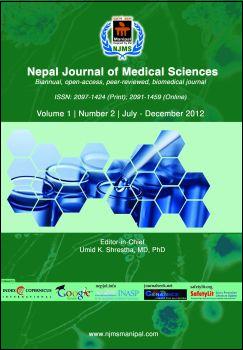Fasting serum lipids and fundus changes in hypertensive patients
DOI:
https://doi.org/10.3126/njms.v1i2.6609Keywords:
Hypertensive retinopathy, serum lipids, serum cholesterol, triglyceridesAbstract
Background: To evaluate fasting serum lipid profile and fundus changes in hypertensive patients,and grade the hypertensive status.
Methods: One hundred consecutive subjects of hypertension, fitting inclusion criteria, with or without prior history of antihypertensive treatment were enrolled in a cross-sectional, descriptive study. Classification of hypertension was done based on The Seventh Report of the Joint National Committee (JNC 7). All the subjects (200 eyes) were subjected to a detailed fundus examination Fundus changes were classified according to Keith, Wagener and Barker (KWB), and Modified Scheie’s grading system. Fasting serum lipids were measured using end point spectrophotometer. Data were collected using a prestructured proforma and analyzed using SPSS 19.0.
Results:The mean age of participants was 58.5 years (SD=9.2 years; range= 33-84 years).One patient,according to the JNC 7 classification of hypertension was in stage 1 while 99 patients were in stage 2. Twenty eight subjects had electrocardiographic a b n o rma l i t y needing prompt treatment. According to KWB classification 54 patients had hypertensive retinopathy (HR), while by Scheie’s grading, 50 patients had HR. Statistically significant difference was found in mean cholesterol, LDL and triglyceride level was seen in different grades of HR.
Conclusion: Significant number of hypertensive patients had HR on first presentation to department of Ophthalmology. Mean serum cholesterol, LDL and triglyceride levels were raised in patients with HR.
DOI: http://dx.doi.org/10.3126/njms.v1i2.6609
Nepal Journal of Medical Sciences. 2012;1(2): 103-7
Downloads
Downloads
Published
How to Cite
Issue
Section
License
Copyright © by Nepal Journal of Medical Sciences. The ideas and opinions expressed by authors of articles summarized, quoted, or published in full text in this Journal represents only opinions of authors and do not necessarily reflect the official policy of Nepal Journal of Medical Sciences or the institute with which the author(s) is (are) affiliated, unless so specified.




